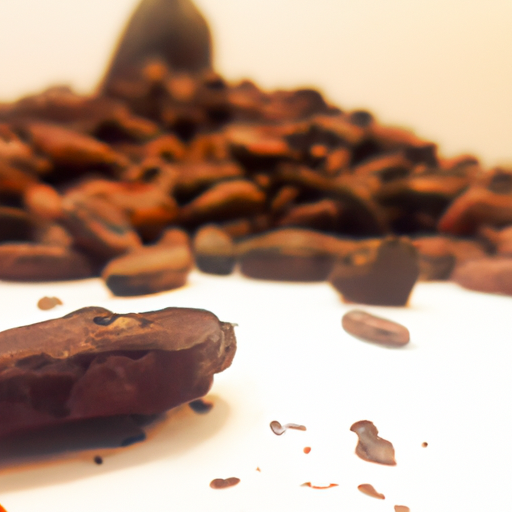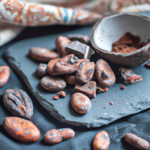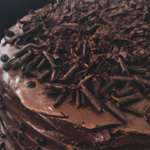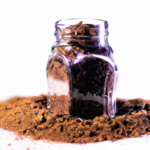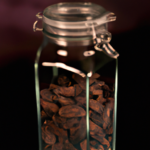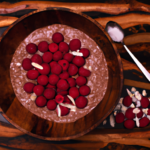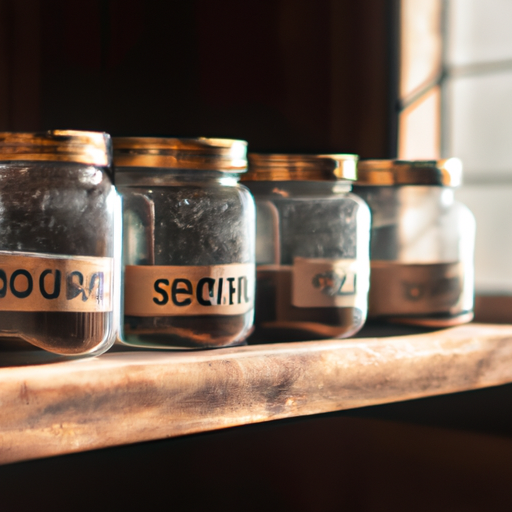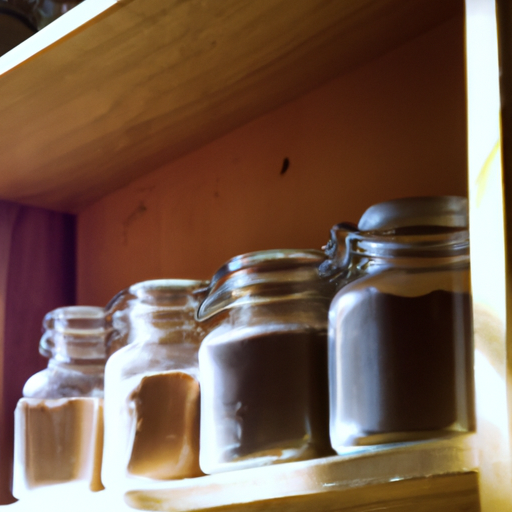I have always been intrigued by the intricate scents that emanate from cacao beans. Being a chocolate enthusiast, I frequently ponder what exactly contributes to the unique aroma of raw cacao nibs. Is there a specific fragrance they should possess, and how can we discern if they are of superior quality?
In this article, we will explore the basics of cacao aromas and delve into the factors that affect the smell of raw cacao nibs. I’ll also share some tips on how to properly smell cacao nibs and identify any off-putting odors. Understanding the scent of cacao can not only enhance our cacao experience but also help us determine freshness and quality.
So, let’s embark on this aromatic journey together and uncover the secrets behind the captivating smell of raw cacao nibs.
Key Takeaways
- Fermentation contributes to the aroma of high-quality cacao nibs.
- Different cacao origins offer diverse taste profiles, which in turn affects the aroma.
- Proper storage in a cool, dark place helps preserve the aroma of cacao nibs.
- Incorporating complementary aromas such as lavender, orange, peppermint, or rose can enhance the overall aroma of cacao nibs.
Understanding the Basics of Cacao Aromas
Understanding the basics of cacao aromas is essential for appreciating the nuances of different varieties and determining the quality of cacao nibs. The complex and rich aromas emitted by raw cacao nibs can range from earthiness and nuttiness to fruity and floral undertones. These aromas are subjective and can vary from person to person based on scent memories. Some individuals prefer the deep, earthy scent of cacao nibs, evoking memories of rich soil and dark forests. Others are drawn to the nutty aroma, reminiscent of roasted almonds or hazelnuts. Additionally, some appreciate the fruity and floral undertones, bringing to mind the vibrant scents of berries or delicate flowers. The scent profile of high-quality raw cacao nibs is a crucial factor in determining their overall quality and desirability.
The Scent Profile of High-Quality Raw Cacao Nibs
When it comes to high-quality raw cacao nibs, the first thing that strikes me is the rich and intense chocolate aroma. It’s a scent that immediately transports me to a world of indulgence and decadence.
Alongside the chocolate notes, there are also nutty and earthy undertones that add depth and complexity to the aroma.
And if you pay close attention, you might even detect subtle hints of floral and fruity notes, adding a touch of brightness to the overall scent profile.
Rich and Intense Chocolate Aroma
Indulge in the irresistible aroma of raw cacao nibs, a tantalizing blend of richness and intensity that will transport your senses to a world of pure chocolate bliss.
The fragrance of cacao nibs is truly unique, with a distinct chocolate scent that is both alluring and captivating. A thorough chocolate scent analysis reveals the intricate layers of this aroma, from the initial wave of sweetness to the deep, velvety undertones.
The scent of high-quality raw cacao nibs is rich and intense, with a depth that lingers in the air and entices you to take a closer sniff. As you inhale, you can almost taste the deep cocoa notes, as if you were standing in the heart of a chocolate factory.
Beneath the surface of this aromatic experience lie nutty and earthy undertones that add complexity to the overall scent profile.
Nutty and Earthy Undertones
Beneath the surface of the rich and intense chocolate aroma, the scent of cacao nibs reveals nutty and earthy undertones. These undertones add a captivating complexity to the overall olfactory experience. They are an integral part of the sensory evaluation of raw cacao nibs.
The nutty undertones provide a delightful contrast to the deep, robust chocolate notes. They create a harmonious symphony of scents. On the other hand, the earthy undertones further enhance this sensory experience. They evoke images of the lush rainforest floor where cacao beans are grown.
As I inhale the intoxicating fragrance, I am transported to a world of natural wonders and flavors. These nutty and earthy undertones seamlessly transition into the subsequent section about floral and fruity notes. This adds another layer of intrigue to the olfactory journey.
Floral and Fruity Notes
The floral and fruity notes burst forth, like a bouquet of blossoms and a basket of ripe, juicy fruit, adding a vibrant and delightful dimension to the overall aroma experience.
These fragrant elements create a harmonious symphony with the nutty and earthy undertones, enhancing the complexity of raw cacao nibs’ scent.
The floral and fruity pairings offer a refreshing contrast to the rich, deep aroma, creating a sensory experience that is both invigorating and enticing.
It is important to note that the development of these notes is influenced by the fermentation process. During fermentation, natural yeasts and bacteria break down the sugars present in the cacao pulp, transforming them into aromatic compounds.
This transformation contributes to the development of the floral and fruity aromas that are characteristic of high-quality raw cacao nibs.
As we delve into the factors that affect the smell of raw cacao nibs, we will explore the crucial role of fermentation in detail.
Factors That Affect the Smell of Raw Cacao Nibs
Imagine holding a handful of raw cacao nibs and exploring the factors that influence their smell. Understanding aroma compounds is crucial in comprehending the various scents that can emanate from these nibs.
The fermentation process plays a crucial role in shaping the smell of raw cacao nibs. Firstly, the duration of fermentation affects the development of aromatic compounds. Longer fermentation times often result in stronger and more complex aromas.
Secondly, the temperature at which fermentation occurs can also impact the smell. Higher temperatures can potentially lead to more intense and robust scents.
Lastly, the specific strains of yeast and bacteria present during fermentation can contribute unique aromas to the cacao nibs.
By considering these factors, we can better appreciate the diverse range of smells that raw cacao nibs can possess.
Transitioning into the subsequent section about how to properly smell raw cacao nibs, it is important to understand the factors that influence their aroma.
How to Properly Smell Raw Cacao Nibs
To properly smell raw cacao nibs, follow these steps:
- Delicately bring the nibs close to your nose.
- Inhale deeply to capture the nuances of their scent.
- Understand scent profiles to develop a refined sense of smell for cacao nibs.
The aroma of raw cacao nibs can be described as:
- Rich and earthy, with hints of nuttiness and a subtle floral undertone.
- Notes of fruitiness, ranging from berries to tropical fruits.
- Influenced by the origin of the cacao beans, with some regions offering pronounced citrus or spice aromas.
Exploring the scent is crucial in identifying off-putting odors in cacao nibs. In the subsequent section, we will discuss how to identify any undesirable smells present in the nibs.
Identifying Off-putting Odors in Cacao Nibs
Now that we know how to properly smell raw cacao nibs, let’s talk about identifying off-putting odors in cacao nibs. It is important to be able to detect any rancid odor or fermentation notes in the nibs, as this can indicate that they are no longer fresh or of high quality. To help you understand what to look out for, I have created a table below that showcases different odors you might encounter when smelling cacao nibs, along with their corresponding descriptions and emotions they may evoke. By being able to identify these odors, you can ensure that you are using only the freshest and best-quality cacao nibs in your recipes. In the next section, we will explore how to use scent to determine the freshness and quality of cacao nibs without relying on visual cues.
| Odor | Description | Emotion |
|---|---|---|
| Rancid | A strong, unpleasant smell similar to spoiled food | Disgust |
| Fermentation | A sour, tangy scent reminiscent of fermented fruits | Curiosity |
| Earthy | A rich, organic aroma reminiscent of freshly turned soil | Comfort |
| Nutty | A sweet, nutty smell reminiscent of roasted nuts | Delight |
| Floral | A fragrant, flowery scent reminiscent of blooming flowers | Elegance |
Using scent to determine freshness and quality is an essential skill for any cacao enthusiast.
Using Scent to Determine Freshness and Quality
Utilizing my olfactory senses is a vital skill if I aspire to ascertain the freshness and quality of cacao nibs. By using scent as a quality indicator, I can determine whether the cacao nibs are still in their prime or if they have started to deteriorate.
When smelling raw cacao nibs, I should expect a rich, earthy aroma with hints of chocolate and fruitiness. This delightful scent is a result of the fermentation process, where the cacao beans undergo controlled fermentation to develop their distinct flavor and aroma.
The role of fermentation in cacao aroma cannot be overstated, as it contributes to the complex and enticing scent that indicates high-quality cacao nibs.
With this knowledge, I can confidently explore different varieties and origins of cacao, knowing that the aroma will guide me towards the best options.
Exploring Different Varieties and Origins
Immerse yourself in a world of tantalizing flavors and captivating aromas as you explore the wide array of cacao varieties and their unique origins.
Variety selection plays a crucial role in flavor development, as different cacao beans from various regions offer distinct taste profiles. For instance, beans sourced from Madagascar are known for their fruity and citrusy notes, while those from Ecuador boast a rich and earthy flavor.
The diversity in origins allows for a range of experiences, making each bite a delightful adventure. By understanding the nuances of different cacao varieties, you can truly appreciate the complexity and depth of flavors they offer.
As we delve deeper into enhancing your cacao experience with aromatherapy, we’ll discover how scent can further elevate your enjoyment without missing a beat.
Enhancing Your Cacao Experience with Aromatherapy
Indulge yourself in an enchanting cacao experience by allowing the captivating scents of aromatherapy to enhance each delectable bite. Aromatherapy offers a myriad of benefits that can elevate your enjoyment of raw cacao nibs.
Here are four scents that pair beautifully with cacao:
-
Lavender: Its calming aroma complements the rich, earthy flavors of cacao, creating a soothing and relaxing experience.
-
Orange: The citrusy scent of orange uplifts your mood and adds a refreshing twist to the intense taste of cacao.
-
Peppermint: This invigorating scent pairs harmoniously with cacao, creating a refreshing and revitalizing combination.
-
Rose: The delicate floral notes of rose add a touch of elegance to the complex flavors of cacao, making each bite a truly luxurious experience.
By incorporating these aromas into your cacao ritual, you can enhance the sensory pleasure and elevate your overall enjoyment.
Now, let’s explore some tips for properly storing and preserving the aroma of cacao nibs.
Tips for Properly Storing and Preserving the Aroma of Cacao Nibs
Properly storing and preserving the aroma of cacao nibs is crucial for maintaining their freshness and unique fragrance. Here are some tips to help you achieve this:
-
Use an airtight container: Keeping cacao nibs in an airtight container is essential to prevent any outside odors from compromising their delicate aroma. This will help preserve their freshness and ensure that their unique scent remains intact.
-
Avoid strong odors: Make sure to store cacao nibs away from any strong odors, as they can easily absorb and take on the scent of surrounding substances. Keeping them separate from spices, strong-smelling foods, or cleaning products will help maintain their distinct aroma.
-
Store in a cool, dark place: Cacao nibs should be stored in a cool and dark place, such as a pantry or cupboard. Exposure to heat and light can cause the nibs to lose their freshness and aroma more quickly. By keeping them in a cool and dark environment, you can help extend their shelf life and preserve their delightful fragrance.
By following these simple yet effective storing techniques, you can fully enjoy the delightful aroma of cacao nibs whenever you indulge in their rich and complex flavors.
Frequently Asked Questions
Can cacao nibs have different smells based on their origins?
Origin plays a crucial role in the aroma variations of cacao nibs. The unique scents of different origins can range from floral and fruity to earthy and nutty. Exploring the diverse origins adds depth to the sensory experience of cacao nibs.
Is there a specific aroma that indicates the freshness of cacao nibs?
There are specific freshness indicators for cacao nibs that can be detected through smell testing. A fresh batch of cacao nibs will have a rich, chocolatey aroma that is distinct and enticing.
Can the smell of cacao nibs change over time?
Yes, the smell of cacao nibs can change over time due to aging effects. As cacao nibs age, their aroma might become less pronounced or develop a slightly musty scent.
Are there any off-putting odors that could indicate the presence of contaminants in cacao nibs?
There’s a saying that goes "a whiff of trouble." When it comes to cacao nibs, off-putting odors can be a sign of contaminants. Any unpleasant smells should raise concerns about the quality and safety of the nibs.
Can aromatherapy techniques enhance the aroma of cacao nibs when consumed or used in recipes?
Aromatherapy techniques can enhance the aroma of cacao nibs, enhancing their flavor when consumed or used in recipes. Additionally, cacao nibs have various health benefits, making them a great addition to any diet.
What Should Raw Cacao Nibs Smell Like When They are Freshly Made?
During the raw cacao nibs production process, the cacao beans are fermented and roasted, resulting in a rich, chocolatey aroma. When they are freshly made, the raw cacao nibs should have a strong, earthy scent with hints of chocolate and fruit, indicating their top quality.
Conclusion
In conclusion, smelling raw cacao nibs is essential for understanding their quality and freshness. By using our sense of smell, we can identify desirable aromas of high-quality cacao, such as fruity, floral, or nutty notes.
It is fascinating to note that research has shown our sense of smell can evoke strong emotional responses. Certain scents can trigger memories and enhance our overall experience.
So, next time you encounter the aroma of raw cacao nibs, take a moment to appreciate their unique and delightful scent.

